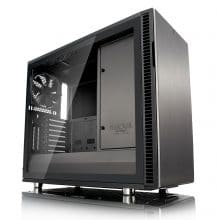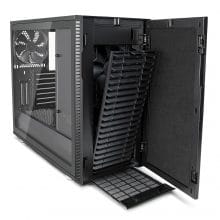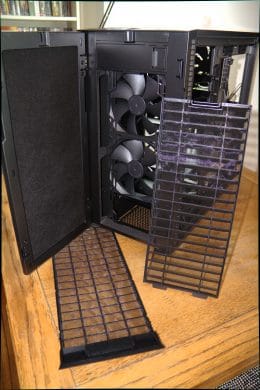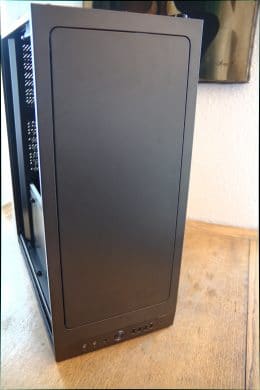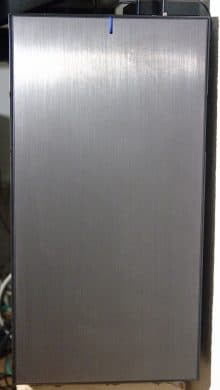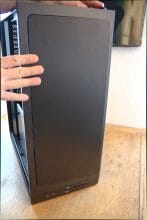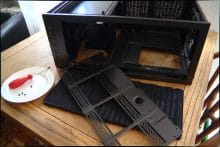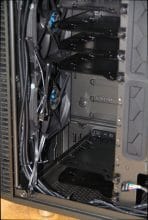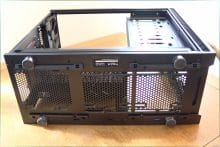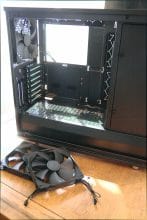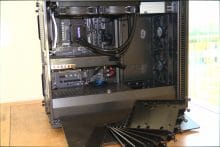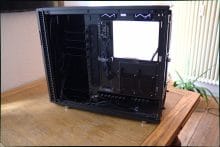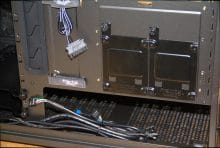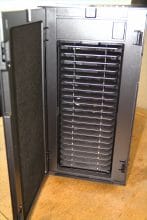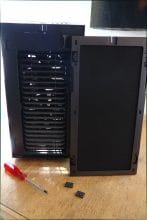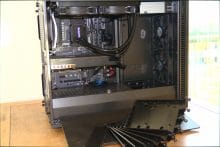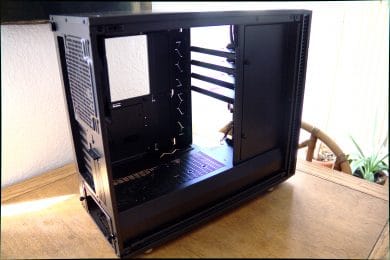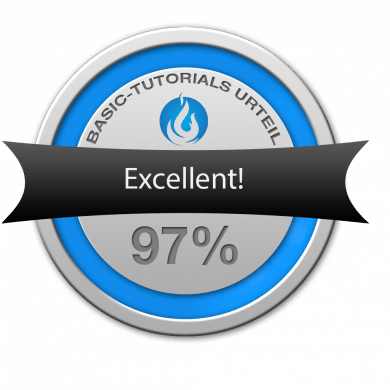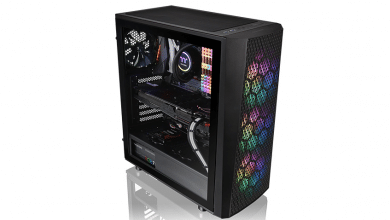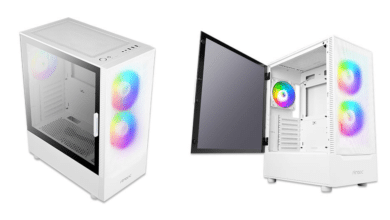
Fractal Design has developed the Midi-Tower Define R6, which promises extensive modularity. On delivery – also called standard mode – the Define R6 is apparently a mature workstation, especially because it offers a lot of space for drives. The housing can also be transformed into an open layout in just a few steps. Then there is also plenty of room for your own water cooling system. Both layouts offer enough space for hardware, with graphics cards, for example, there are hardly any restrictions. Fractal Design has also added some surprising features to the Define R6.
In our test, we not only look at the quality of the case, but also try out the conversion to an open layout. Overall we liked the Define R6 very much. But then we discovered some flaws.
Scope of Delivery
In addition to the pre-installed fans and dust filters as well as the PWM hub, the housing is supplied with extensive mounting material:
- 6x drive bays (pre-assembled)
- Vibration damper for drives
- Drive screws
- Mainboard spacer
- Mainboard screws
- power supply screws
- Screws for conversion
- Cable ties
- Microfibre cloth for cleaning
- Comprehensive manual
Altogether more than enough screws are included for the conversion from standard to open layout.
Technical Data:
| Product name | Fractal Design Define R6 Gunmetal TG | Comments |
| Material | Steel, tempered glass, plastic | |
| Color | Titanium grey | |
| No. of PCI slots | 7 + 2 Vertical | Riser cable is not |
| Front connections | 2x USB 3.0, 2x USB 2.0, Audio, Reset, On/Off | white LED ring, narrow stripe protrudes into the front |
| Memory components | ||
| Standard layout | 6x 2.5″/3.5″ Racks | |
| 1x 5.25″ | ||
| Open layout | 2x 3.5″ Rear side of drive support | |
| 1x 5.25″ | official, see Text | |
| Both layouts | 2x 2.5″ | Behind the mainboard tray |
| 2x 2.5 | with the brackets from the mainboard tray | |
| Fans | ||
| Front | 2x 140 mm, 3x 120 mm | 2x 140 mm pre-installed |
| Rear | 1x 140/120 mm | 1x 140 mm pre-installed |
| Cover | 3x 140/120 mm | without 5.25″ bracket |
| Floor | 2x 140/120 mm | |
| Radiators | ||
| Front | max. 280/360 mm | |
| Rear | 1x 140/120 mm | |
| Floor | max. 280/240 mm | Official specification with reservation, see text |
| Lid (max. 35 mm height of the motherboard components) | max. 280/360 mm | Standard layout |
| max. 420/360 mm | open layout, partly without 5.25″-bracket | |
| Dimensions | 543 x 465 x 233 mm | Length x Height x Width |
| Motherboard size | E-ATX (up to 285 mm width), ATX, mATX, ITX | |
| Maximum component sizes | ||
| Graphics card | max. 440 mm | In standard layout max. width 155 mm from 300 mm length with fan mounted on the front |
| CPU cooler | 185 mm | |
| Power supply unit | 300 mm | |
| Weight | 12.4 kg | |
| Price | no longer available | |
No Lightweight
When we accept the packaging from the extremely annoyed DHL courier, we are surprised by the weight and were happy that we didn’t have to lift the almost 12 kilogram parcel up to the fourth floor ourselves. Unpacked, the Define R6 presents itself remarkably simple, the surfaces are flat, the case has clear edges. It is clearly deeper than high, the width corresponds to the usual Midi Tower.
The front is made of brushed aluminium throughout, except for a small recess at the top in the middle, which releases the lower part of the white LED of the Power Button. The front is a door that opens to reveal a blind-like screen with the first of a total of three dust filters. The screen can be removed with a handle on the top. Behind it are two of the three pre-installed fans. Fractal Design has opted for 140mm fans that draw in air through side inlets that are located in the frame around the front door. Alternatively, three 120 fans can be installed here. The fans can also be replaced with correspondingly large radiators. The frame itself is made of plastic. The hinges of the internally insulated door can be placed on the right or left side. All you have to do is remove the screws of the hinges on the door and reposition them.
Easily Accessible I/O panel
Below the LED is a slot for a 5.25-inch drive or a fan controller – no longer a matter of course. The corresponding bracket is about one third as long as a standard optical drive. According to the instructions, the plug-in unit is only available in the standard configuration. More about that later.
The I/O panel has Fractal Design attached to the front of the top. Besides the power button, there are two USB 3.0 and two USB 2.0 slots, which are not color-coded but labeled. There is also a reset switch and the usual plugs for audio in and out. Behind the I/O panel is a flap that covers almost the entire surface of the top. Like the frame of the lid, it is also made of steel and turns out to be the heaviest removable part of the entire housing. It can be released by simply pressing a button on the back of the housing.
Modular Lid
There is also a screen on the underside of the flap. Underneath is another insulating mat. The second dust filter is mounted between the screen and the insulating mat. The cover and dust filter can be separated from the insulated cover with a little pressure. Fractal Design has patented this process under the name ModuVent. On the one hand, it makes it easier to clean the dust filter. On the other hand, the dust filter and screen can also be mounted on the upper side again without a cover.
This improves the airflow when either two 140 mm or three 120 mm fans are to be mounted on the top side – or corresponding radiators that do not cross the heat exchangers, which are mounted on the front side. For easy mounting of fans or radiators on the lid, Fractal Design has provided the Define R6 with a bracket that can be removed by loosening a total of four screws. Particularly practical for custom water cooling systems is the round recess in the bracket to which a refill nozzle can be attached.
Vertical PCI Slots for Graphics Cards
A further 140 mm fan is pre-installed at the rear. These include the usual seven PCI slots. In addition, there are two other vertical slots to which a graphics card can be attached. The riser cable required for this is not included in the housing. The distance to the left side panel made of Tempered Glass is large enough for a 2.5 slot graphics card to fit vertically. There is also plenty of room for the CPU fan with 185 millimeters. Graphics cards can be a total of 400 millimeters long, even if there are fans at the front. In the standard layout, the high HDD cage between the mainboard tray and the front is somewhat in the way. Graphics cards longer than 300 millimeters must not be wider than 155 millimeters including cable connections.
The HDD cage consists of the support panel next to the mainboard tray on one side, which extends from the lid to the bottom. The right rails are attached directly to the housing. For HDD or SSD drives, Fractal Design has included six slots with rubber dampers and screws, but a total of eleven fit there. At the back of the mainboard tray there is a holder for two additional SSDs, which can alternatively be attached to the power supply cover. The entire front side of the HDD cage has a screwed-in screen decorated with an inconspicuous Fractal Design logo stamped into it.
Power Supply Cover Is Firmly Riveted
The power supply cover extends from the back to the end of the mainboard tray or to the support panel of the HDD cage, then there is a recess in the cover cover. At the top there are diagonally arranged ventilation slits. For the ATX power supply, which can be up to 300 millimetres deep, there are rubber feet on the floor. According to the manual, radiators up to 280 millimeters can be placed on the floor in the open layout. But since the power supply cover is firmly riveted, and double radiators cannot be forced through the much too small recess at the front, they must instead be pushed from the back to the intended position before the power supply is installed.
For AiOs with fixed connections, this is likely to be extremely difficult, if not impossible, due to the limited height. In addition, the recess for the power supply unit is considerably narrower than 140 millimetres, which is why a 120 millimetre wide radiator without connections, which must also be fitted with fans beforehand, can pass through without much fiddling at most. To ensure that the cables for the power supply have enough space, the radiator must also be pushed all the way to the front. Only then can it be connected to the water circuit through the recess. It may then collide with another radiator on the front. In the open design, i.e. without the drive cage, a 120 mm or 140 mm radiator at the bottom of the front panel or better a compensation tank as part of a custom water cooling system fit stress-free in the open design.
Comprehensive Conversion Campaign
The conversion from standard to open design is to move the HDD cage support panel to the rear of the case. It then forms an extension of the mainboard tray and the space behind it for the cable management, which is kept tight at 23 millimetres, but still offers sufficient space. During conversion, the housing must be taken apart as far as possible. The front door and frame as well as the lower air filter, which fortunately can be pulled out to the front and extends over the entire underside, have to be removed as well as the lid with the upper bracket and the short holder for the 5.25-inch drive. The screen with the Fractal Design logo must also be unscrewed; it will later hide the view of the back and the data carriers and cables attached there.
The support is then removed and turned 90 degrees before it is fastened again at the bottom and from the front with two screws each. With two further screws the support is finally screwed to the upper bracket. There’s nothing to complain about about the stability afterwards. Two vertically screwed 3.5-inch data carriers still fit on the back of the offset support. For SSDs there are no fixings provided, we have found a remedy with double-sided adhesive tape and were able to accommodate two more of them.
Fewer Open Layout Drives
So while there is room in the standard layout for a total of six 3.5-inch or 2.5-inch and two additional SSDs, the official number in the open layout is reduced to two 3.5-inch and two 2.5-inch drives.
According to the instructions, the 5.25-inch slot must be omitted in the open layout. Nevertheless, we managed to install a Blu-Ray player without any problems, even with a subsequent 280mm radiator on the upper side, even though the optics aren’t flawless anymore, because the DVD drive is then visible through the transparent side panel.
PWM Fan Hub with Many Slots
There are sufficient recesses including rubber sheaths for a mature cable management. Speaking of cables: Fractal Design has given the Define R6 a PWM hub for fans, which is attached to the back of the mainboard tray. It is supplied with power via a SATA connector on the power supply unit to drive the fans connected to it. After all, a total of three 4-pin and six 3-pin fans fit there. The three 4-pin slots will later be occupied by the three 14-inch Dynamic X2 GP-14 fans that Fractal Design has pre-assembled in the case.
The fans run at a maximum of 1,000 rpm and are actually quiet 18.9 dB(A). The volume flow is 115.5 m³/h and they normally cool quite well. But with our AMD Radeon Vega 64 in the reference design with only one fan they were understandably overwhelmed. The Ryzen-2700X CPU and its stock fan naturally also contributed to the high temperatures. But even when we cooled down the CPU with a 280 AiO from be quiet! on the lid to a reasonable 30 to 35 degrees in normal operation, the fans didn’t manage to cool the graphics card sufficiently.
Better Airflow Without Front Door
We observed that the temperature inside the case dropped up to five degrees when we opened the front door and removed the PCI slot bezels on the back. The front door can be completely removed to improve airflow, but the hangers on the door hinge frame are quite prominently placed and interfere with the look of the otherwise attractive front. In addition, the acoustic insulation, which is glued to the back of the front door, is of course omitted.
We simply replaced the fans – of course with RGB LED lighting. After all, we wanted to put the tidy interior of the Define R6 in the limelight. The Corsair HD-140s run at higher rpm, but unfortunately are also louder than Fractal Design’s HD-140s. Only then did the temperature of the graphics card remain within a reasonable range, but it still became too hot when doddling graphically more demanding games.
Heat Wave as Hardness Test
Replacing the AiO with a CPU tower cooler and attaching two more Corsair fans to the lid made hardly any changes. It should be noted that these observations were made during the heat wave of the last few days – a test of endurance, so to speak. We tried the AiO at the front and a vertical airflow with two fans at the bottom and two at the lid. In the end we came to the conclusion that a horizontal airflow with the AiO on the lid is the most effective structure.
Until we switch to custom water cooling for the CPU and graphics card, we make do with a table fan that blows air through the open door. It cools the feet at the same time. In any case, you should invest in more fans if you have strong hardware and make sure you buy a graphics card with efficient cooling. However, our construction should also sweat in other housings.
A Lot of Space for Radiators (With Reservation)
For a self-constructed water cooling there is enough space for radiators in the Define R6 – apart from the floor because of the already mentioned restrictions – especially in the open layout. Even with a slightly deeper 280 mm radiator at the front, a compensation tank with pump fits into the front recess of the power supply cover. In the standard layout, 120 mm wide radiators up to a length of 360 mm and 140 mm wide heat exchangers up to 280 mm fit simultaneously at the front and at the top. In the open layout there is even more space on the lid, a radiator can be up to 420 mm long. On the back side, both versions keep the width at 120 mm.
Diversity of the Define R6
Our version is the Define R6 in Gunmetal with a side made of tempered glass. The fans are completely in black, the PCI slot bezels are in the case color. The version with tempered glass is also available in black with white fan blades, white drive bays and white PCI slot bezels as well as completely in black. The white version of the Define R6 with tempered glass has an outer black front door and PCI slot bezels in the same color. The fans are completely in white. All these variants are also available without tempered glass.
All models of the Fractal Design Define R6 can be found here at Caseking.
Fractal Design Define R6 Review
The Define R6 from Fractal Design skilfully combines function with design. It simply comes from the case from Sweden, but without seeming boring. The brushed aluminium of the front door, the venetian blinds in front of the air filters on the lid and the front also look chic. It’s a shame that Fractal Design didn’t place the hinges on the front of the door more discreetly, so that you can do without the door if you wanted to – or had to.
It is unfortunate that Fractal Design has firmly riveted the power supply cover. This will obstruct or even prevent the installation of large radiators or AiOs on the floor, as the manufacturer advertises in its operating instructions. However, there is still enough space on the front and especially on the lid for additional radiators and the recess in the power supply cover perfectly accommodates an expansion tank with pump.
There is nothing wrong with the workmanship of the case. The materials are all of high quality and well processed. The edges are all neatly deburred and the components of the extraordinarily modular case fit perfectly, regardless of whether you choose the standard layout or the open layout. The Define R6 is equally suitable for those who want to build a mature workstation and those who want to build the perfect gaming computer.
Fractal Design Define R6
Workmanship
Design
Features
Damping
Cooling
Value for Money
The Define R6 from Fractal Design is a well thought out and chic case with many options, except for some minor criticisms.
